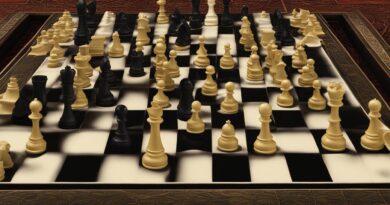Queen and Rook vs. King and Queen in Chess
A pawnless chess endgame is a rare occurrence in practice, but certain pawnless endgames, such as Queen and Rook vs. King and Queen, are important to understand. In this particular endgame, the side with the Queen and Rook has a significant advantage. It is crucial to drive the opponent’s King away from the Rook to secure a win. However, optimal play is necessary, as the game can end in a draw after 50 moves if no piece has been captured or pawn has moved.
Key Takeaways:
- Queen and Rook vs. King and Queen is an important pawnless endgame to understand.
- The side with the Queen and Rook has a significant advantage in this endgame.
- Driving the opponent’s King away from the Rook is crucial for securing a win.
- Optimal play is necessary as the game can end in a draw after 50 moves with no captures or pawn moves.
- Studying and practicing this endgame can enhance chess gameplay skills and strategic thinking.
The Basics of Pawnless Chess Endgames
In the realm of chess, pawnless endgames present unique challenges and strategic opportunities. These endgames occur when only a few pieces remain on the board, without any pawns. They often require precise maneuvering and thoughtful decision-making to secure a favorable outcome. Understanding the basics of pawnless endgames is essential for every chess player’s repertoire.
One of the fundamental aspects of pawnless endgames is the checkmate. These types of endgames include scenarios such as King and Queen vs. King, King and Rook vs. King, and Queen vs. Rook. In these positions, major pieces such as Queens and Rooks play a crucial role in executing checkmate, while minor pieces like Knights and Bishops provide additional strategic elements.
Pawnless Endgame Examples
To illustrate the dynamics of pawnless endgames, let’s examine two common scenarios:
| Endgame | Description | Key Strategies |
|---|---|---|
| Queen and Rook vs. King | In this endgame, the side with the Queen and Rook has a significant advantage. The primary objective is to drive the opponent’s King away from the Rook, creating checkmate opportunities. Optimal play and tactical awareness are crucial to secure a win. | Focus on tactical maneuvers such as forks and checkmates with the Queen. |
| Queen vs. Rook | The Queen vs. Rook endgame is another fascinating pawnless scenario. The Queen holds the advantage in this position, but the defending Rook can employ defensive strategies to create difficulties for the attacking Queen. The “third-rank defense” and the Philidor position are two notable defensive techniques. | Navigate the “third-rank defense” position and aim to force the Rook into the Philidor position for a favorable outcome. |
Understanding the intricacies of pawnless endgames, including the role of major pieces and the nuances of key positions, is pivotal to becoming a well-rounded chess player. By studying and practicing these endgames, players can refine their strategic thinking, enhance their decision-making skills, and become more proficient in executing winning plans.
Summary
Pawnless endgames in chess offer unique challenges and strategic possibilities. Understanding the basics of these endgames is essential for players looking to enhance their chess skills. Major pieces like Queens and Rooks play a crucial role, while minor pieces add tactical elements. Examples like Queen and Rook vs. King and Queen vs. Rook showcase different strategies and positions that require careful maneuvering and optimal play for victory.
Queen vs. Rook Endgame
In the Queen vs. Rook endgame, the Queen holds a significant advantage and is usually able to secure a win against a lone Rook. The Queen’s superior mobility and ability to control both long-range and close combat make it a formidable force on the board. To maximize the chances of victory, players must focus on employing tactical maneuvers such as forks and checkmates with the Queen.
However, the defense can be challenging for the Rook. One particularly difficult defensive position is the third-rank defense. In this scenario, the Rook is positioned on the third rank, while the opponent’s King is on the opposite side. The defending Rook must carefully maneuver to prevent the Queen from infiltrating and exploiting weak points. This requires strategic planning and precision to maintain a solid defense and avoid forced checkmates or significant material losses.
Another critical position in the Queen vs. Rook endgame is the Philidor position. In this setup, the side with the Queen aims to force the Rook into a specific position, often on the first rank, to restrict its mobility and create favorable attacking opportunities. By skillfully maneuvering the Queen and coordinating with other pieces, the stronger side can gradually tighten the grip and eventually secure a decisive victory.
Table: Queen vs. Rook Winning Positions
| Position | Description |
|---|---|
| Third-rank defense | The Rook defends from the third rank while preventing the Queen’s penetration |
| Philidor position | The Queen forces the Rook into a limited area for a strategic advantage |
| Checkmate positions with the Queen | Various tactical patterns leading to checkmate with the Queen |
Mastering the Queen vs. Rook endgame requires not only an understanding of winning positions but also the ability to navigate the complexities of defense. By studying and practicing various scenarios, players can develop the tactical acumen and strategic thinking necessary to consistently achieve success in this captivating endgame.
Queen vs. Two Minor Pieces Endgame
In the pawnless endgame of Queen vs. Bishop and Knight, the Queen is generally considered to have the advantage and a higher chance of winning. However, it is not always an easy task to secure a victory against the defensive fortresses formed by the Bishop and Knight.
While the Queen possesses greater mobility and attacking potential, the Bishop and Knight can create a strong defensive alliance. Their ability to cover squares of different colors and work together can create a resilient barrier that hinders the Queen’s progress. It is crucial for the Queen to find a way to break through this defensive setup.
Defensive Fortresses in Queen vs. Bishop and Knight Endgame
There is one drawing fortress position that is particularly challenging for the Queen to overcome. It is known as the “wrong-colored bishop fortress.” In this position, the Bishop is strategically placed on a square that matches the opposite color of the promotion squares. As a result, the Bishop effectively prevents the enemy King from approaching and leading to a win for the Queen.
However, it is important to note that in most cases, the Queen does have the upper hand against a Bishop and Knight. With careful maneuvering, tactical awareness, and strategic play, the Queen can create weaknesses in the defensive formation and gradually gain an advantage. Players should study various positions and master the key concepts and strategies to effectively guide the Queen to victory.
| Queen vs. Two Minor Pieces Endgame | Outcome |
|---|---|
| Queen vs. Bishop and Knight | Queen usually wins |
| Defensive fortresses | Challenges the Queen’s progress |
| Wrong-colored bishop fortress | Creates a drawing fortress position |
Rook vs. Bishop and Rook Endgame
In the pawnless endgame of Rook vs. Bishop and Rook, the outcome typically results in a draw, unless specific positions arise where the defending King becomes trapped in a corner. The Rook holds a higher value compared to the Bishop, but the Bishop possesses the ability to control diagonal squares, limiting the Rook’s maneuverability. This dynamic creates a delicate balance between the two pieces, often leading to a stalemate.
To break the equilibrium and increase winning chances, players can employ various defensive strategies. One notable defensive method is the Cochrane Defense, named after Scottish chess player John Cochrane. This defensive setup involves placing the defending Rook behind the Bishop, creating a barrier to deter the attacking Rook’s advances. The Cochrane Defense aims to control the second rank and restrict the opposing Rook’s movement, thus preventing potential breakthroughs.
Another defensive approach frequently utilized in the Rook vs. Bishop and Rook endgame is the “second-rank defense.” By activating the defending Rook on the opponent’s second rank, it creates an additional layer of protection for the King and restricts the enemy Rook’s horizontal movement. The second-rank defense is effective in preventing the enemy Rook from infiltrating the back rank and launching devastating checks.
Table: Rook vs. Bishop and Rook Endgame Strategies
| Defensive Strategy | Description |
|---|---|
| Cochrane Defense | Placing the defending Rook behind the Bishop to obstruct the attacking Rook’s progress |
| Second-rank defense | Activating the defending Rook on the opponent’s second rank to guard against horizontal threats |
The Rook vs. Bishop and Rook endgame poses intriguing challenges for players. The defensive fortresses established through strategies like the Cochrane Defense and the second-rank defense can neutralize the attacking potential of the Rook and create a balanced outcome. Understanding these defensive methods and their applications is vital for players seeking to navigate this intricate pawnless endgame successfully.
Common Pawnless Endgames with Rook and Minor Pieces
The pawnless endgames involving a Rook and minor pieces, namely Rook vs. Bishop and Rook vs. Knight, are common and require specific strategies to secure a win. In the Rook vs. Bishop endgame, drawing fortresses can often prevent the Rook from achieving victory. These fortresses create a barrier that the Rook finds difficult to breach, leading to a potential draw. On the other hand, in the Rook vs. Knight endgame, the Knight’s close proximity to the King and its placement play a crucial role in deciding the outcome of the game.
Rook vs. Bishop Endgame
In the Rook vs. Bishop endgame, the Rook generally has good winning chances due to its long-range capabilities and the Bishop’s limited mobility. However, defensive fortresses can be set up, which can make it difficult for the Rook to find a breakthrough. A fortress is a strategic setup where the defending side arranges their pieces in a way that the Rook cannot penetrate the defenses and deliver checkmate. These fortresses are often constructed near the edge of the board, exploiting the limited space and reducing the Rook’s attacking potential.
Rook vs. Knight Endgame
Contrary to the Rook vs. Bishop endgame, the Rook vs. Knight endgame offers greater defensive possibilities for the side with the Knight. The Knight’s unique movement pattern allows it to control squares that may be out of reach for the Rook. It can also create tactical threats, especially when it is close to the enemy King. The outcome of the Rook vs. Knight endgame depends heavily on the placement of the Knight and the King’s position. Proper coordination of these pieces is crucial for the defending side to hold their ground or even achieve a draw.
Mastering the intricacies of these endgames can significantly improve a player’s strategic understanding and decision-making in pawnless positions. By studying and analyzing various positions, players can learn to exploit the weaknesses in the opponent’s fortress or fortify their own defenses, leading to successful outcomes in these challenging endgames.
Practice and Study the Queen vs. Rook Endgame
To become proficient in the Queen vs. Rook endgame, it is essential to practice and study various positions. By practicing from different starting positions, players can familiarize themselves with different tactical and strategic elements required to achieve victory. Additionally, reviewing annotated games and video lessons can provide valuable insights and enhance understanding of the nuances of the endgame.
Studying the Queen vs. Rook endgame involves analyzing key positions and understanding the optimal moves and plans for both sides. This includes learning how to use the Queen’s mobility and attacking potential to force the Rook into unfavorable positions. It also involves mastering defensive techniques with the Rook to hold off the Queen’s threats and secure a draw.
Table: Queen vs. Rook Endgame Practice Positions
| Position | Starting Player | Result |
|---|---|---|
| Position 1 | White | Win |
| Position 2 | Black | Draw |
| Position 3 | White | Loss |
| Position 4 | Black | Win |
By practicing these positions and analyzing the moves and outcomes, players can develop a deeper understanding of the Queen vs. Rook endgame. It is also important to study annotated games played by top players to observe their strategies and decision-making process in different positions. Video lessons from experienced players can further supplement the learning process, providing visual and verbal explanations of key concepts and techniques.
Remember that thorough practice and study of the Queen vs. Rook endgame can improve your overall chess skills and enhance your ability to strategize and make accurate decisions in complex situations. By honing your understanding of this endgame, you will gain a competitive advantage and be better equipped to handle similar scenarios in your future chess games.
Important Considerations in Pawnless Chess Endgames
In pawnless endgames, optimal play by both sides is crucial in determining the outcome. To maximize your chances of success, it’s important to understand the strategic considerations and the rules that govern these endgames.
Optimal Play
Optimal play is essential in pawnless endgames, where every move can have a significant impact on the outcome. It involves making accurate decisions that maximize your chances of winning or securing a draw. In Queen and Rook vs. King and Queen endgames, optimal play often focuses on driving the opponent’s King away from the Rook to secure a win. Additionally, knowing tactical motifs, such as forks and checkmates, can help you capitalize on opportunities and gain an advantage.
The Fifty-Move Rule
Understanding the fifty-move rule is crucial in pawnless endgames. According to this rule, if no pawn has been moved or piece has been captured within 50 moves, the game is declared a draw. This rule is important to consider when evaluating your winning chances or deciding whether to force a win or play for a draw. It adds an element of time pressure and forces players to make strategic decisions within a limited timeframe to avoid a draw.
| Important Considerations | Explanation |
|---|---|
| Optimal Play | Make accurate decisions that maximize winning chances |
| The Fifty-Move Rule | Game ends in a draw if no pawn has moved or piece has been captured within 50 moves |
Conclusion
Mastering pawnless endgames, especially Queen and Rook vs. King and Queen, is a crucial aspect of enhancing your chess gameplay skills. By studying and practicing these endgames, you can develop a deep understanding of the strategies and tactics involved, allowing you to make accurate decisions in critical moments.
These endgames require optimal play, whereby you must understand when to push for a win or aim for a draw. Pay attention to the fifty-move rule, as it can impact the outcome of the game if no piece has been captured or pawn has moved within 50 moves.
By expanding your knowledge and familiarity with these specific positions, you can sharpen your strategic thinking and gain an advantage over your opponents. So, invest time in studying annotated games, watching video lessons, and practicing various positions to enhance your chess endgame strategies and elevate your gameplay skills.
FAQ
Are pawnless endgames common in practice?
No, pawnless endgames are rare in practice, but certain pawnless endgames, such as Queen and Rook vs. King and Queen, are important to understand.
Which side has the advantage in the Queen and Rook vs. King and Queen endgame?
The side with the Queen and Rook has a significant advantage in this endgame.
How can I win the Queen vs. Rook endgame?
Optimal play involves driving the opponent’s King away from the Rook to secure a win. Tactics like forks and checkmates with the Queen are key strategies.
What is the third-rank defense in the Queen vs. Rook endgame?
The third-rank defense is a position where the Rook is on the third rank and the enemy King is on the other side. This position requires careful maneuvering to secure a win.
Is there a drawing fortress position in the Queen vs. Rook endgame?
Yes, there is a drawing fortress position that can be formed, creating a barrier against the enemy King’s approach.
Can a Queen win against a Bishop and Knight?
In most cases, a Queen wins against a Bishop and Knight, but defensive fortresses can make it challenging for the Queen to force a win.
Is the Rook vs. Bishop endgame usually a draw?
Yes, the Rook vs. Bishop endgame is usually a draw, except in specific positions where the defending King is trapped in a corner.
What are some defensive methods in the Rook vs. Rook endgame?
The Cochrane Defense and the “second-rank defense” are two defensive methods that players can employ to mitigate the attacking potential of the Rook and Bishop.
How can I secure a win in the Rook vs. Bishop endgame?
Drawing fortresses can often prevent the Rook from achieving victory in the Rook vs. Bishop endgame.
What is important in the Rook vs. Knight endgame?
The Knight’s close proximity to the King and its placement play a crucial role in deciding the outcome of the Rook vs. Knight endgame.
How can I become proficient in the Queen vs. Rook endgame?
To become proficient, it is essential to practice and study various positions. Reviewing annotated games and video lessons can also provide valuable insights.
What is the fifty-move rule?
The fifty-move rule states that the game is a draw if no piece has been captured or pawn has moved within 50 moves.
Why are pawnless endgames important to understand in chess?
Understanding pawnless endgames enhances chess gameplay skills and strategic thinking, allowing players to anticipate tactics, make accurate decisions, and gain an advantage in critical moments of the game.


